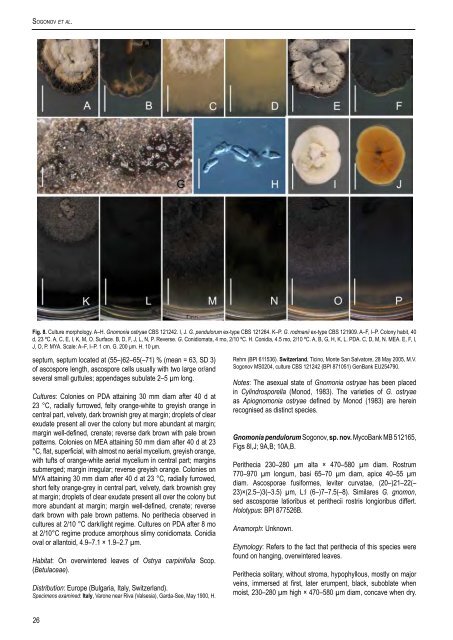Leaf-inhabiting genera of the Gnomoniaceae, Diaporthales - CBS
Leaf-inhabiting genera of the Gnomoniaceae, Diaporthales - CBS
Leaf-inhabiting genera of the Gnomoniaceae, Diaporthales - CBS
You also want an ePaper? Increase the reach of your titles
YUMPU automatically turns print PDFs into web optimized ePapers that Google loves.
So g o n o v e t a l.<br />
Fig. 8. Culture morphology. A–H. Gnomonia ostryae <strong>CBS</strong> 121242. I, J. G. pendulorum ex-type <strong>CBS</strong> 121264. K–P. G. rodmanii ex-type <strong>CBS</strong> 121909. A–F, I–P. Colony habit, 40<br />
d, 23 ºC. A, C, E, I, K, M, O. Surface. B, D, F, J, L, N, P. Reverse. G. Conidiomata, 4 mo, 2/10 ºC. H. Conidia, 4.5 mo, 2/10 ºC. A, B, G, H, K, L. PDA. C, D, M, N. MEA. E, F, I,<br />
J, O, P. MYA. Scale: A–F, I–P. 1 cm. G. 200 μm. H. 10 μm.<br />
septum, septum located at (55–)62–65(–71) % (mean = 63, SD 3)<br />
<strong>of</strong> ascospore length, ascospore cells usually with two large or/and<br />
several small guttules; appendages subulate 2–5 µm long.<br />
Cultures: Colonies on PDA attaining 30 mm diam after 40 d at<br />
23 °C, radially furrowed, felty orange-white to greyish orange in<br />
central part, velvety, dark brownish grey at margin; droplets <strong>of</strong> clear<br />
exudate present all over <strong>the</strong> colony but more abundant at margin;<br />
margin well-defined, crenate; reverse dark brown with pale brown<br />
patterns. Colonies on MEA attaining 50 mm diam after 40 d at 23<br />
°C, flat, superficial, with almost no aerial mycelium, greyish orange,<br />
with tufts <strong>of</strong> orange-white aerial mycelium in central part; margins<br />
submerged; margin irregular; reverse greyish orange. Colonies on<br />
MYA attaining 30 mm diam after 40 d at 23 °C, radially furrowed,<br />
short felty orange-grey in central part, velvety, dark brownish grey<br />
at margin; droplets <strong>of</strong> clear exudate present all over <strong>the</strong> colony but<br />
more abundant at margin; margin well-defined, crenate; reverse<br />
dark brown with pale brown patterns. No peri<strong>the</strong>cia observed in<br />
cultures at 2/10 °C dark/light regime. Cultures on PDA after 8 mo<br />
at 2/10°C regime produce amorphous slimy conidiomata. Conidia<br />
oval or allantoid, 4.9–7.1 × 1.9–2.7 µm.<br />
Habitat: On overwintered leaves <strong>of</strong> Ostrya carpinifolia Scop.<br />
(Betulaceae).<br />
Distribution: Europe (Bulgaria, Italy, Switzerland).<br />
Specimens examined: Italy, Varone near Riva (Valsesia), Garda-See, May 1900, H.<br />
Rehm (BPI 611536). Switzerland, Ticino, Monte San Salvatore, 28 May 2005, M.V.<br />
Sogonov MS0204, culture <strong>CBS</strong> 121242 (BPI 871051) GenBank EU254790.<br />
Notes: The asexual state <strong>of</strong> Gnomonia ostryae has been placed<br />
in Cylindrosporella (Monod, 1983). The varieties <strong>of</strong> G. ostryae<br />
as Apiognomonia ostryae defined by Monod (1983) are herein<br />
recognised as distinct species.<br />
Gnomonia pendulorum Sogonov, sp. nov. MycoBank MB 512165,<br />
Figs 8I,J; 9A,B; 10A,B.<br />
Peri<strong>the</strong>cia 230–280 µm alta × 470–580 µm diam. Rostrum<br />
770–970 µm longum, basi 65–70 µm diam, apice 40–55 µm<br />
diam. Ascosporae fusiformes, leviter curvatae, (20–)21–22(–<br />
23)×(2.5–)3(–3.5) µm, L:l (6–)7–7.5(–8). Similares G. gnomon,<br />
sed ascosporae latioribus et peri<strong>the</strong>cii rostris longioribus differt.<br />
Holotypus: BPI 877526B.<br />
Anamorph: Unknown.<br />
Etymology: Refers to <strong>the</strong> fact that peri<strong>the</strong>cia <strong>of</strong> this species were<br />
found on hanging, overwintered leaves.<br />
Peri<strong>the</strong>cia solitary, without stroma, hypophyllous, mostly on major<br />
veins, immersed at first, later erumpent, black, suboblate when<br />
moist, 230–280 µm high × 470–580 µm diam, concave when dry.<br />
26

















